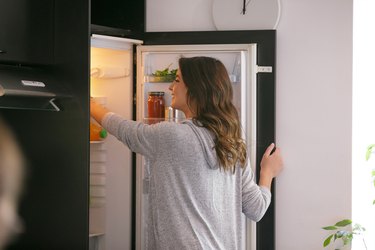
Most of us can relate to this scenario: You had great intentions when you filled your grocery cart with healthy foods like fresh fruit and vegetables. But then you shoved them in the fridge drawers and forgot about them until weeks later (not a pretty sight).
Sometimes stocking your fridge with wholesome food is only half the battle, especially if you're trying to lose weight. The other pertinent part of the equation is fridge organization. Indeed, where you place your foods — and whether they're easily accessible — is equally as important.
Video of the Day
Video of the Day
Here, Jaclyn London, RD, CDN, head of nutrition and wellness at WW (formerly Weight Watchers), shares five tips for arranging your refrigerator that'll help set you up for weight-loss success.
1. Pair Healthy Food Combos
Sometimes the only thing standing between you and a healthy snack is time. To simplify your life and streamline your snacking, store your favorite grab-and-go treats (think: carrots and hummus, apples and peanut butter) in the same drawer for convenience, the Cleveland Clinic recommends.
One of London's favorite, no-fuss hacks — fresh fruit skewers — is the perfect example. Simply wash and chop your favorite fruit (or use pre-cut fruit) and make fruit kabobs: pair cubes of pineapple and clementine slices, bananas with halved strawberries or mango with blueberries. Then toss a few "sticks" in a Ziploc with nuts or seeds for a beautifully balanced snack that's ready to go and perfectly portable.
2. Categorize and Label Foods
"Anything you can do to make it easier to add more fruits and veggies to your daily meals and snacks, do it," London says.
One way to do that: Organize, store and label foods by type.
This makes healthy foods quicker and easier to find — and unhealthy foods that much easier to avoid, according to the Cleveland Clinic. To that end, it might be worth investing in individual baskets or food containers for optimal organization.
3. Store Nutritious Foods on Center Shelves
What good is the kale you bought if you can't find it in your fridge?
"The truth is, you're more likely to reach for healthful food and snacks when they're in your sightline," London says.
That's why it's smart to keep items like fruits, vegetables, lean proteins, seafood and your favorite unsweetened beverages front and center.
You'll want to stock water in a central spot too. Many people mistake hunger for thirst. So, before you reach for something to eat, hydrate first.
That said, when organizing your fridge, you should also keep food safety in mind, London says. Some foods need to maintain the right temperature to stay fresh. Here's a quick guide — courtesy of London — to help you arrange your foods safely:
- Store leafy greens, lettuce and anything pre-cut or sliced in crisper drawers.
- Meat, seafood, poultry, dairy and eggs, plus veggie-heavy leftovers, should go in the middle of the fridge, toward the back. That's the coolest part, which will help them stay fresh the longest.
- The door gets the most "action" from a temperature standpoint, so use it for condiments, iced coffee, wine and anything else that's safe at room temp.
4. Make a DIY Salad Bar
"One of the biggest barriers to getting in those good-for-you-foods is ingredient prep (because honestly, who wants to chop veggies after a long day?!), so having your mise-en-place ready to go will naturally eliminate the urge to say no way and order takeout," London says.
This is especially true when it comes to making salad. If all your ingredients are prepped, a hearty, leafy bowl of greens is just minutes away.
"So instead of tossing your fruits and veggies haphazardly into produce bins, set aside some time to wash, chop and store in clear containers on the second shelf of your fridge," London says.
You can also stock other healthy salad ingredients — like beans, chickpeas and edamame — in nearby bins so you can build your own salad bowl in a breeze.
To cut back on prep time, buy fresh produce that's in-season and pre-cut, London suggests. "Pre-made slaws and stir-fry veggie combos can be game-changers," she adds.
5. Stash Less-Healthy Foods Out of Sight
Indulging in your favorite foods (even if they're not necessarily nutritious) is an important part of a healthy, balanced way of eating. But to help you from overdoing it, eat the serving you like, and then store the rest out of sight, London says. In other words, in a less-accessible area like the back of your fridge on the bottom shelf. This way you're not tempted for a taste every time you open the fridge.
Storing irresistible treats in your freezer is another smart strategy.
"Think of your freezer as a security safe where you put high-value items for safekeeping like, say, candy," London says. "When you do want to grab a bite, it'll take a little time to thaw, allowing for satiety signals to kick in before going back for seconds."
Ready to Lose Weight?
Set yourself up for success with LIVESTRONG.com's Weight-Loss Kickstart program.
Was this article helpful?
150 Characters Max
0/150
Thank you for sharing!
Thank you for your feedback!